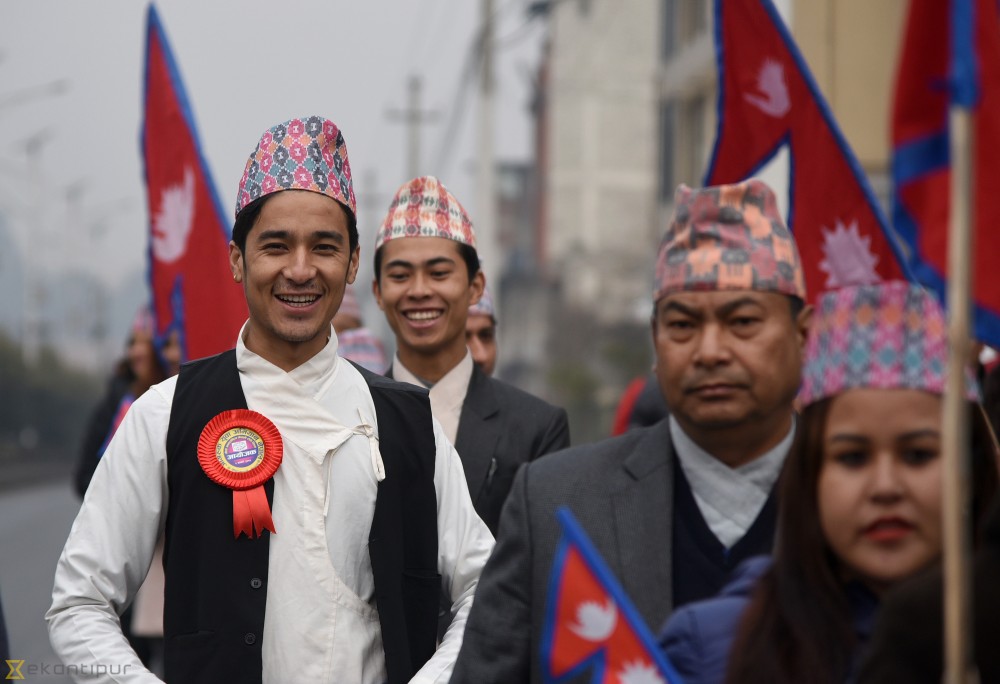
Image source: https://enewspolar.com
The Dhaka Topi is a proud symbol of Nepali identity, culture, and solidarity that goes much beyond simple traditional clothing. Its story has been rooted in the history of the country, crossing both space and time, and has been passed down through the centuries. A timeless representation of legacy and belonging, each fold and pattern captures not just the artistry of master craftsmen but also the determination and pride of the Nepali people.
The Story Beyond Fabric
Beyond being a piece of attire, the Dhaka Topi also tells a story of Nepali craftsmanship and unity. Woven by skilled hands in rural hills, it carries the sweat of artisans, the rhythm of folk songs, and the pride of generations. In the context of Nepali tradition, wearing a Dhaka Topi is like carrying Nepal itself—a portable crown of identity that connects them to their roots, no matter where in the world they stand.
In every fold, weave, and pattern, the Dhaka Topi remains a timeless emblem of Nepali heritage where this crown itself speaks of pride, culture, and a shared history.
Historical & Political Importance
During the Panchayat period, a Dhaka Topi was an indispensable attire for men to be captured in any official photo or to have its presence in the government offices.It became an issue concerning national duty and cultural pride. Still today, the Nepali men continue to wear a Dhaka Topi in passports and citizenship photos as a symbol of respect and authenticity.
When Do We Wear It?
Traditionally, the Dhaka Topi is worn on several formal occasions, national holidays, and cultural programs. A few are Dashain, Tihar, Constitution Day, weddings, government functions, and International Nepali Day. For the Nepali society, it is a proud expression of their Nepali heritage whenever worn for community functions or ceremonies.
How Is It Made?
Dhaka, the fabric of a Topi, is traditionally woven by hand in the countryside areas such as Palpa and Terhathum. Craftswomen-women mostly-weave the complex patterns with the backstrap loom.
Global Identity
For Nepali’s living abroad, the Dhaka Topi is more than dress—it is a remembrance of home. Then, on days like Constitution Day, Dashain, or International Nepali Day, people would wear Dhaka Topi to “carry Nepal on their head”/carrying Nepal on their heads to express their proud heritage wherever they are around the globe.
Artisan & Economic Connection
Every Dhaka Topi showcases the talent of rural craftspeople, particularly the ladies of Palpa and Terhathum, who spend hours sitting down to weave their unique fabric. Each Topi supports generations of this craft, local economies, and historical traditions in addition to identity.
Symbol in Literature & Music
Nepali literature and folk songs have also incorporated the Dhaka Topi. It stands for respect, pride, and manhood, becoming a Heritage, which is preserved in songs and poems like “Topi Dhaka Ko,” tying cultural memory to daily existence.
Generational Shift
While most elders would look at the Dhaka Topi with respect for tradition, the youth are more likely to see it as a fashion statement. This equilibrium shows that cultural symbols can grow and shift yet still retain their deep meaning.
As a result, the Dhaka Topi is a prime example of cultural evolution as time and generations change. From the Palpa hills to Nepali communities scattered across the world, it serves as a timeless reminder that the greatest way of remembering heritage is to proudly put it on and embrace it rather than just to preserve it.




